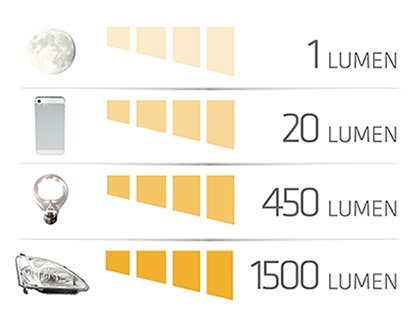Ever wondered how bright a light bulb is? Measuring light output can be confusing. Traditional methods make it hard to know which metrics are important.

I’ll make the complex world of light measurement simple. We’ll explore how lumens are measured and their importance. You’ll learn to choose the right lighting for any space.
Whether you’re a homeowner, designer, or lighting expert, knowing about lumens is key. It changes how you pick and check light sources. Let’s explore the world of light measurement together!
Understanding the Basics of Light Measurement
Light measurement can seem complex, but I’ll simplify it for you. Light is more than just brightness. It’s a scientific measurement that affects many areas, from home lighting to photography.
Measuring light involves several key components. These help us understand how illumination works. Let’s look at the basics of light measurement and why it’s important.
What Is a Lumen?
A lumen shows the total visible light from a source. It’s like a brightness rating. Unlike watts, which measure energy use, lumens measure light output. So, higher lumens mean more light.
- Lumens quantify total light produced
- Measures visible light from a source
- Direct indicator of brightness
Lumens vs. Watts: Understanding the Difference
Many think watts show brightness, but they measure power use. Lumens give a better idea of light. For instance, a 10-watt LED might shine brighter than a 60-watt incandescent bulb. So, lumens are better for measuring light intensity.
Key Components of Light Measurement
Light measurement includes more than just lumens. Lux shows light intensity on a surface. This helps professionals see how light works in real life. By using both lumens and lux, we get a full picture of light output and its uses.
Read also: How to Fix Foggy Windows
- Lumens: Total light output
- Lux: Light intensity on a surface
- Candela: Light intensity in a specific direction
The Science Behind Luminous Flux
Luminous flux is key to understanding light. It measures the visible light a source emits. This gives us insights into how comfortable light is for different uses. Scientists say luminous flux is the total light energy a source sends out over time.
The science behind luminous flux is quite interesting. It tells us how much light a source makes that we can see. Unlike just light energy, luminous flux looks at light our eyes can see.
- Measured in lumens (lm)
- Represents total visible light output
- Weighted according to human eye sensitivity
The candela-steradian relationship is important. A lumen is the same as one candela-steradian (cd·sr). This might sound complex, but it’s about how light spreads in space. It helps designers know how light will work in different places.
Lighting experts use luminous flux to check visual comfort in many places. They use it for offices, homes, and industrial areas. Knowing how light spreads is key for the best visual experience.
How Are Lumens Measured in Modern Lighting
Measuring lumens is a complex task that needs special tools and precise methods. It involves understanding how different lights are measured. This process includes detailed lab tests and strict rules.
Experts use advanced tools to measure light accurately. These methods are much more detailed than just looking at the light.
Professional Measurement Equipment
To get accurate lumens, experts use several important tools:
- Integrating spheres for total light output measurement
- Spectroradiometers for precise spectral analysis
- Goniophotometers to map light distribution
- Luminance meters for surface brightness evaluation
Laboratory Testing Procedures
Testing lumens in labs involves several key steps. Scientists make sure their tools are set right to get accurate readings for all light types.
| Testing Stage | Purpose | Key Measurement |
|---|---|---|
| Initial Calibration | Establish baseline measurement standards | Equipment precision |
| Light Source Preparation | Stabilize light source | Consistent operating conditions |
| Spectral Analysis | Evaluate light wavelengths | Comprehensive light characteristics |
Industry Standards and Protocols
Standards are key in lumen measurement. Groups like the Illuminating Engineering Society (IES) make strict rules. These rules help ensure everyone follows the same standards.
By knowing these detailed methods, we see the science behind every lumen rating. This process turns complex light measurements into useful info for everyone.
Comparing Lumens to Other Light Measurements

To grasp illuminance measurement, it’s key to understand the different light units. Lumens are not the only way to measure light. Various systems help both experts and everyday people get a clear picture of light.
Let’s dive into the main light measurement units that are most important for measuring light:
- Foot-candles: A traditional British measurement
- Lux: The metric system’s standard unit
- Candelas: Measuring light intensity in a specific direction
Now, let’s see how these units are connected. One foot-candle is equal to one lumen per square foot. In the metric system, a lumen per square meter is called a lux. To be exact, one foot-candle is about 10.57 lux.
| Unit | Measurement Context | Conversion Factor |
|---|---|---|
| Foot-candle | Imperial lighting measurement | 1 fc = 10.57 lux |
| Lux | Metric lighting measurement | 1 lux = 0.0929 foot-candles |
| Candela | Light intensity in a direction | Measures luminous intensity |
Experts use these measurements based on their lighting needs. Architects might use lux for European standards, while American contractors often use foot-candles. Knowing these conversions is vital for accurate light measurement in different situations.
The Relationship Between Lumens and Light Intensity
Light measurement is more than just how bright something is. In the lighting world, experts look at detailed metrics to understand light. Lumens are not just a number on a bulb; they’re a scientific way to measure light.
Light intensity uses scientific units like candela and steradians. These help designers and engineers make accurate lighting plans. They show how light spreads and behaves.
Understanding Candela and Steradians
Candela shows light intensity in one direction. It’s a basic unit in bulb ratings. Steradians measure light spread in three dimensions.
Converting Between Different Light Units
- 1 candela = Light intensity in a specific direction
- 1 steradian = Three-dimensional light angle measurement
- 683 lumens = Power of one watt at 555 nm wavelength
Practical Applications in Lighting Design
Lighting designers use these units for precise lighting plans. They understand how lumens, candela, and steradians work together. This helps them design spaces with exact light distribution.
| Light Unit | Definition | Practical Use |
|---|---|---|
| Lumens | Total light output | Measuring bulb brightness |
| Candela | Light intensity in one direction | Directional lighting design |
| Steradians | Three-dimensional light spread | Calculating total light coverage |
Learning about these light measurement techniques helps you understand how experts create well-lit spaces. They meet strict industry standards.
Lumen Ratings in Different Light Sources
Understanding light sources can be confusing. Knowing about lumen ratings helps you pick the right light for any room. It’s not just about numbers; it’s about setting the right mood for your space.
Each light source has its own lumen output. Here’s a quick look at the main differences:
- Incandescent bulbs: Usually 1600 lumens for a 100-watt bulb
- LED lights: More energy-efficient, shining brighter with less power
- Compact fluorescent (CFL): Offers good light with energy savings
Lumen meters and sensors are key for measuring light accurately. They help both makers and buyers see how much light a source gives.
When you’re looking for lights, keep this guide in mind:
- Bedroom or ambient lighting: 1000-2000 lumens
- Kitchen or workspace: 3000-4000 lumens
- Outdoor security lighting: 700-1300 lumens
Today’s lighting tech has changed how we see brightness. LEDs are super efficient, giving you more light with less energy. Always check the lumen rating before buying any light.
Pro tip: Don’t just look at watts – focus on lumens to truly understand a light source’s brightness!
Measuring Light Output in Commercial Applications
In the world of professional lighting, measuring light output is key. It ensures quality and performance. I’ll explain the detailed techniques used by industries to measure light accurately.
Photometry techniques have changed how we measure light. Commercial lighting experts use advanced tools to get precise data on light performance.
Professional Light Metering Tools
Today, we use many advanced instruments for light measurement:
- Spectroradiometers for precise spectral analysis
- Goniophotometers for angular light distribution
- Integrating spheres for total luminous flux measurement
Industry Standards for Light Measurement
The Illuminating Engineering Society of North America (IES) sets strict guidelines for light measurement. These standards help ensure consistency and reliability in different lighting technologies.
| Measurement Tool | Primary Function | Accuracy Level |
|---|---|---|
| Spectroradiometer | Spectral power distribution | ±1% |
| Goniophotometer | Angular light distribution | ±2% |
| Integrating Sphere | Total luminous flux | ±3% |
Quality Control in Light Manufacturing
Manufacturers follow strict quality control to check light output. This includes several testing stages:
- Initial prototype testing
- Production batch sampling
- Final product verification
By sticking to these high standards, companies make sure their lighting products work as expected. They provide consistent light for various uses.
Common Challenges in Lumen Measurement

Measuring luminous flux is not simple. Lighting experts face many challenges when they do precise calculations. These issues can affect how well lighting standards are followed.
The main problems in lumen measurement are:
- Spectral variations in different light sources
- Directional light output inconsistencies
- Environmental interference during measurements
- Equipment calibration limitations
Understanding how light spectra impact measurements is key. LEDs and traditional lights have different spectra. This makes standard measurements harder.
| Measurement Challenge | Impact on Accuracy | Mitigation Strategy |
|---|---|---|
| Spectral Variability | High | Advanced Spectroradiometric Analysis |
| Directional Light Complexity | Medium | Goniometric Measurement Techniques |
| Environmental Interference | Low | Controlled Testing Environments |
ANSI lumen measurements help standardize. They offer better accuracy than older methods. By using strict testing, makers can provide more trustworthy data on lighting.
The Future of Light Measurement Technology
The world of light measurement is changing fast. New technologies in lumen meters and sensors are leading the way. They are making it easier to measure brightness levels with great accuracy.
Read also: How to Read and Detect Badger Water Meter Problems
Artificial intelligence is changing how we measure light. Smart devices can now detect brightness with amazing precision. These advanced sensors can analyze light in ways we never thought possible.
- AI-powered lumen meters with real-time data processing
- Miniaturized sensors for ultra-precise brightness measurements
- Cloud-connected measurement systems
- Quantum sensing technologies for extreme light level detection
Professionals in lighting are seeing big changes. Lighting designers, researchers, and manufacturers have new tools. These tools offer better measurement, instant data, and detailed spectral analysis.
- Enhanced measurement resolution
- Instant data visualization
- Comprehensive spectral analysis
- Predictive performance modeling
As technology keeps getting better, we’ll see even more advanced ways to measure light. The mix of nanotechnology and advanced computing will open up new areas in light measurement. This will help us understand light in a more detailed and accurate way.
Conclusion
Learning about lumens is more than just knowing a fact—it’s about making your space perfect. Light output is key in both homes and work places. It affects how comfortable and enjoyable a place is.
Exploring light measurement shows us how deep and interesting this field is. Experts use special tools and tests to find out how much light we have. This helps us pick the right bulbs for our homes or work areas.
As technology grows, so does our understanding of light. Knowing about lumens is now more important than ever. It helps us make better choices when picking lights.
Now, you can choose lights with confidence. Whether it’s for your home or a big project, knowing about lumens is essential. It helps us create spaces that are not just bright but also comfortable and efficient.


